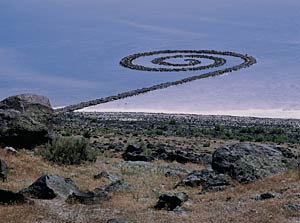A proposal to drill for oil in Utah’s Great Salt Lake could threaten artist Robert Smithson’s monumental 1970 earthwork “Spiral Jetty.” The Canadian firm Pearl Montana Exploration and Production holds three leases, dating to 2003, to drill exploratory boreholes near the iconic sculpture. A public comment period ends tomorrow as state officials evaluate the company’s permit requests.

Pearl submitted a state application on January 11 to drill two wells from floating barges anchored to the lakebed. The move caught artists and conservationists off guard. The 1,500-foot-long mud, salt crystal, and rock Spiral Jetty was supposedly safeguarded under a 19-month-old settlement. In May 2006, preservation groups including Western Resource Advocates, the Sierra Club’s Utah chapter, Friends of Great Salt Lake, and Great Salt Lake Audubon reached an agreement with the state that pulled back oil and gas leases in the northwest arm of the lake. The pact covered 116,000 acres, but left out 55,000 acres; the lake’s Little Valley Harbor, five miles southwest of the Spiral Jetty, falls within the exempted acreage.
Smithson’s 15-foot-wide counterclockwise curlicue is located at the remote Rozel Point in Box Elder County. It was built using heavy machinery and 6,650 tons of basalt and earth. Although rising lake water levels submerged the sculpture during the 1980s, it reemerged following a drought in 1999. That same year the New York-based Dia Art Foundation acquired Spiral Jetty as a gift from the late artist’s estate. Considered to be Smithson’s masterpiece, the sculpture embodies his exploration of entropy—a theme shared by James Wines and other deconstructionist architects during the 1970s—and has been known to generations of architecture and art history students mostly through photographs and a film produced by the artist himself.
“The expansive natural setting is integral to Smithson’s artwork, providing an essential frame for experiencing the Spiral Jetty,” Jeffrey Weiss, foundation director, said in a statement. “Any incursion on the open landscape, including the proposed drilling, would significantly compromise this important work of art.”
Yet drilling, if it’s approved, could begin this year. The state must honor mineral rights, although it still determines drilling terms and conditions. “If there’s a problem, we won’t sign until the problem is solved,” says Brad Hill, permit manager for the Utah Division of Oil, Gas and Mining. The state normally processes permit requests in a couple of weeks but officials extended the public comment period to February 13 following a massive public outcry.
Groups that oppose drilling near the Spiral Jetty include the artist’s widow, Nancy Holt, as well as the Dia Art Foundation, National Trust for Historic Preservation, and Friends of the Great Salt Lake, among others. A revision in Utah’s Great Salt Lake Mineral Leasing Plan of 1996 is expected to play a key role in the permitting decision. The state agreed to pull back leases in 2006 because the plan is outdated.
Oil companies explored the area both before and after Smithson finished his earthwork in 1970. During the 1920s, a drilling company built an offshore rig on a pier near Rozel Point. Amoco drilled in the same spot five decades later, but abandoned the leases when oil prices dropped.


Post a comment to this article
Report Abusive Comment